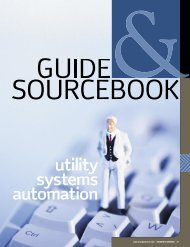We're growing our relationships - and we're making it ... - Description
We're growing our relationships - and we're making it ... - Description
We're growing our relationships - and we're making it ... - Description
Create successful ePaper yourself
Turn your PDF publications into a flip-book with our unique Google optimized e-Paper software.
By Michael G. Morris<br />
News Flash>><br />
www.energycentral.com<br />
STRATEGY NEEDED<br />
The Un<strong>it</strong>ed States,<br />
Mexico <strong>and</strong> Canada<br />
should b<strong>and</strong><br />
together to develop<br />
a North American<br />
energy strategy.<br />
That is the<br />
recommendation<br />
of the former U.S.<br />
energy secretary,<br />
Bill Richardson,<br />
who is now governor<br />
of New Mexico<br />
<strong>and</strong> a possible<br />
c<strong>and</strong>idate for<br />
president in 2008.<br />
“This council will<br />
give <strong>our</strong> hemisphere<br />
the heft we need<br />
to counterbalance<br />
the powerful energy<br />
centers in the Middle<br />
East — creating<br />
more regional<br />
independence,”<br />
Richardson told the<br />
Associated Press.<br />
16 ENERGYBIZ MAGAZINE July/August 2005<br />
Legal Eagle<br />
THE VIEW FROM AEP<br />
Mauled by PUHCA<br />
AN ODD AND extremely frustrating thing happened<br />
to us in early May. We were going about <strong>our</strong> daily<br />
activ<strong>it</strong>ies at American Electric Power — delivering<br />
reliable, affordable electric<strong>it</strong>y to <strong>our</strong> more than 5 million<br />
customers in 11 states, installing add<strong>it</strong>ional environmental<br />
controls on <strong>our</strong> efficient fleet of coal-fired power<br />
plants, <strong>and</strong> continuing necessary work to implement<br />
leading-edge, clean-coal power generation technology<br />
– when we became entangled in the belts, sprockets,<br />
<strong>and</strong> gears of the Public Util<strong>it</strong>ies Holding Company Act<br />
(PUHCA), a regulatory mechanism built in 1935 to<br />
protect investors from Depression-era abuses.<br />
An administrative law judge of the Secur<strong>it</strong>ies<br />
<strong>and</strong> Exchange Commission (SEC) issued an in<strong>it</strong>ial<br />
decision on May 3 that said <strong>our</strong> merger w<strong>it</strong>h Central<br />
<strong>and</strong> South West, approved by the SEC in June 2000<br />
as the last step in 30 months of review by multiple<br />
federal <strong>and</strong> state agencies, meets the interconnection<br />
requirement of PUHCA, but “does not<br />
const<strong>it</strong>ute a ‘single integrated public-util<strong>it</strong>y system’<br />
for failure to be confined in <strong>it</strong>s operations to a single<br />
area or region under (PUHCA).”<br />
What does all that mean? In a nutshell, the merger<br />
had been challenged by public power organizations.<br />
In response, AEP <strong>and</strong> the SEC staff have filed<br />
separate pet<strong>it</strong>ions for review to the SEC — each<br />
supporting the commission’s June 2000 approval<br />
of the merger <strong>and</strong> each taking issue w<strong>it</strong>h interpretations<br />
made by the administrative law judge.<br />
The in<strong>it</strong>ial decision has no effect on the current<br />
structure or operations of <strong>our</strong> company, which has<br />
functioned on a fully integrated basis since the merger<br />
was completed five years ago. We’re confident that<br />
the merger will again prove consistent w<strong>it</strong>h the policy<br />
objectives of PUHCA. However, this in<strong>it</strong>ial decision<br />
changed the focus of merger announcements made<br />
later in the month by Duke <strong>and</strong> Cinergy as well as by<br />
MidAmerican <strong>and</strong> PacifiCorp. Instead of discussing<br />
the potential benef<strong>it</strong>s the mergers bring for consumers<br />
<strong>and</strong> investors, the companies spent much of their time<br />
answering questions about compliance w<strong>it</strong>h PUHCA’s<br />
archaic requirement that the parties be directly interconnected<br />
<strong>and</strong> w<strong>it</strong>h the administrative law judge’s restrictive<br />
interpretation of the single area or region requirement.<br />
I’m confident the in<strong>it</strong>ial decision also triggered<br />
concern at other util<strong>it</strong>ies considering merger plans,<br />
since <strong>it</strong> creates uncertainty on Wall Street. Again, <strong>it</strong><br />
illustrates how PUHCA can be used as a barrier to<br />
consolidation necessary to reduce costs of operations<br />
in the highly fragmented util<strong>it</strong>y sector. The outdated<br />
regulation also serves as a barrier to much-needed<br />
investment in an industry facing a <strong>growing</strong> need for<br />
infrastructure improvements, since fear of entanglement<br />
in PUHCA’s aging regulatory mechanism deters<br />
potential non-PUHCA acquirers of util<strong>it</strong>y assets.<br />
In <strong>it</strong>s 70 years of existence, PUHCA’s now-antiquated<br />
approach to investor protection has been<br />
superseded by much newer, more efficient regulations<br />
to protect investors in today’s instant-access,<br />
high-speed information business environment. The<br />
SEC’s author<strong>it</strong>y to protect investors’ interests is<br />
backed by a database full of regulations that provide<br />
necessary transparency into corporate finances <strong>and</strong><br />
activ<strong>it</strong>ies — regulations that were recently enhanced<br />
by the add<strong>it</strong>ional disclosure requirements of the<br />
Sarbanes-Oxley Act of 2002.<br />
The SEC, the regulatory body charged w<strong>it</strong>h enforcing<br />
PUHCA requirements, has adm<strong>it</strong>ted this regulation<br />
no longer serves a purpose. In 1981, the commission<br />
recommended to Congress that PUHCA be repealed,<br />
saying <strong>it</strong>s “provisions were e<strong>it</strong>her duplicative of other<br />
regulatory schemes or no longer necessary to prevent<br />
the abuses that led to enactment.” The SEC reaffirmed<br />
this recommendation in 1995 in a report issued as<br />
part of then-Vice President Al Gore’s “Reinventing<br />
Government” in<strong>it</strong>iative.<br />
The Senate Banking Comm<strong>it</strong>tee repeatedly has<br />
agreed w<strong>it</strong>h the SEC recommendation, supporting<br />
PUHCA repeal on an almost annual basis in reports<br />
issued under both Democratic <strong>and</strong> Republican<br />
leadership. Yet PUHCA lives on — the same aging<br />
collection of regulatory belts, sprockets, <strong>and</strong> gears<br />
now repainted as an important consumer protection<br />
machine by supporters who ignore the existence of<br />
newer consumer protection regulations.<br />
For instance, all proposed mergers undergo a<br />
thorough ant<strong>it</strong>rust review by e<strong>it</strong>her the Department<br />
of Justice or the Federal Trade Commission. This<br />
review ensures that a proposed merger does not<br />
harm the compet<strong>it</strong>ive balance of the marketplace,<br />
thereby protecting the interests of consumers.<br />
For electric util<strong>it</strong>y mergers, the Federal Energy<br />
Regulatory Commission (FERC) examines potential<br />
market power issues w<strong>it</strong>h consumer protection in


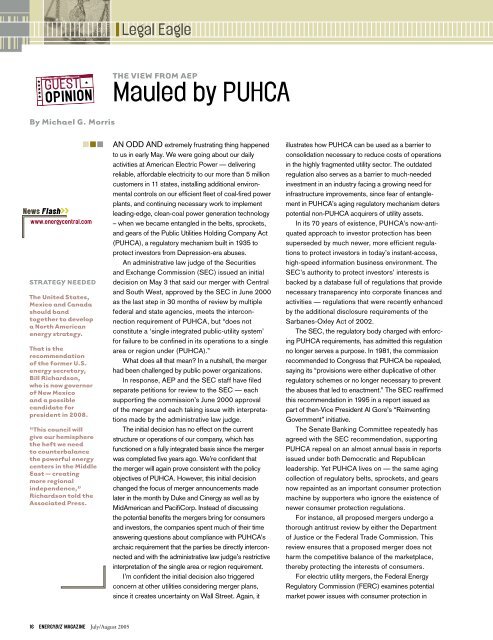

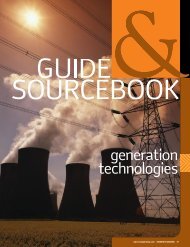
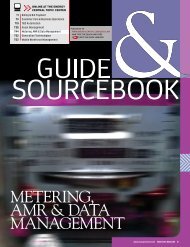

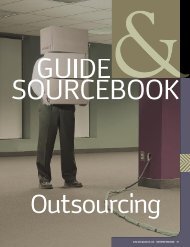




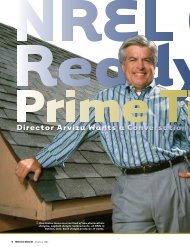


![View From the Trenches [PDF]](https://img.yumpu.com/18854438/1/190x252/view-from-the-trenches-pdf.jpg?quality=85)
